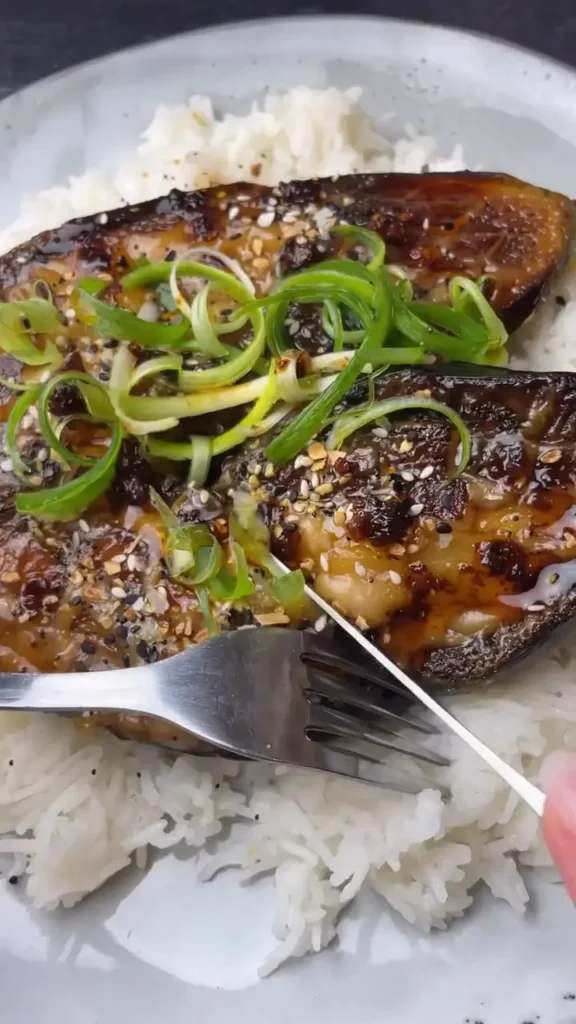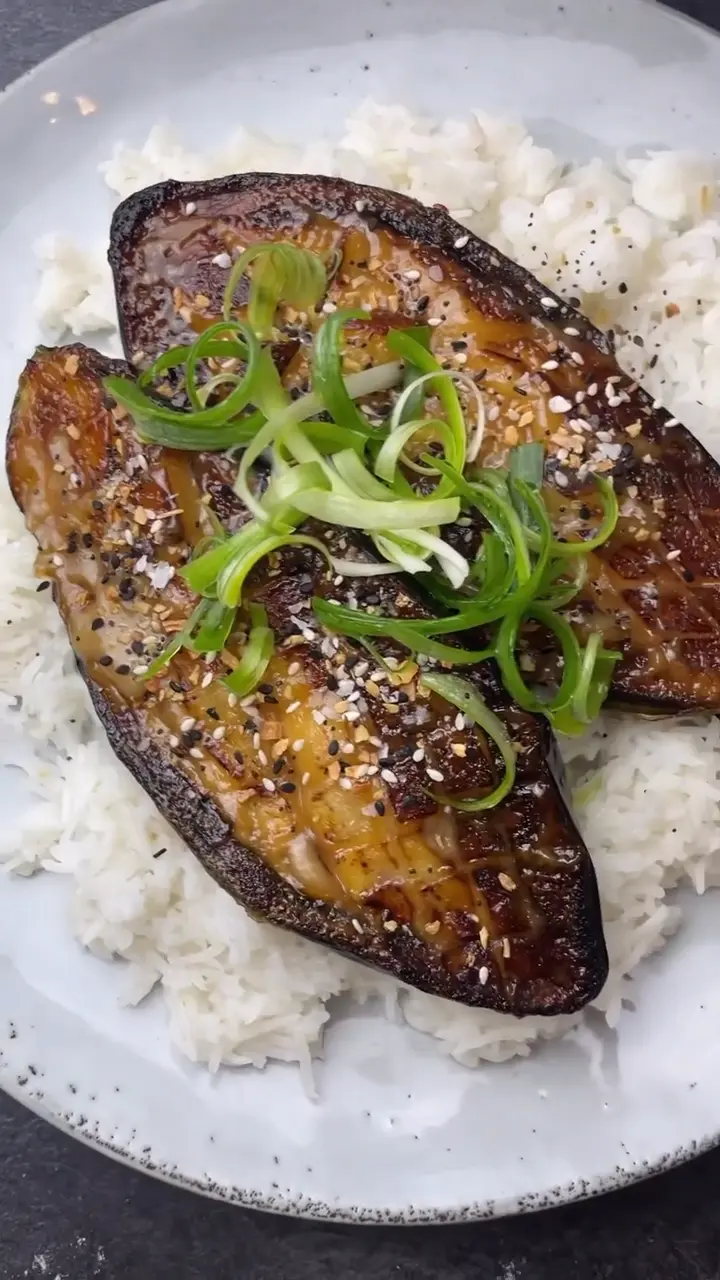Many vegetable dishes can feel repetitive, but this miso glazed eggplant stands out for its perfect balance of flavor and texture.
The eggplant turns soft and buttery in the oven, soaking up the savory-sweet miso glaze that caramelizes beautifully under heat. Every bite offers that irresistible blend of umami, saltiness, and a touch of sweetness, finished with crisp scallions and a drizzle of sesame and chili oil for depth.
Simple to make and elegant to serve, this dish transforms humble ingredients into something extraordinary.
The Beauty of Miso Glazed Eggplant
Eggplant, or aubergine, is often underestimated. When treated right, it becomes one of the most luxurious vegetables to cook with. In this recipe, its spongy flesh absorbs the glaze like a sponge, allowing each slice to burst with complex savory richness.
The key lies in roasting and glazing at just the right moment. The miso mixture thickens, caramelizes, and seeps into the scored surface of the eggplant. The result is a glossy, golden topping and a melt-in-your-mouth interior. It’s a dish that looks refined but takes surprisingly little effort—perfect for both weeknight dinners and special occasions.
This preparation pairs beautifully with steamed rice, but it can also accompany dishes like garlic butter shrimp scampi or creamy mushroom pasta for a balanced, flavor-forward meal.
Choosing the Right Eggplant

Not all eggplants are created equal. The type and freshness make a noticeable difference in the final texture. Smaller eggplants, such as Japanese or Chinese varieties, have thinner skins and a more delicate flavor. They cook faster and absorb marinades more evenly than large globe eggplants.
Select one that feels firm and heavy for its size, with glossy skin and no soft spots. A fresh eggplant will have a slight bounce when pressed and a bright green stem. Avoid older or wrinkled ones—they tend to turn bitter or spongy when roasted.
Preparing the Eggplant for Maximum Flavor
Preparation is where much of the magic begins. The key technique here is scoring. Cutting deep diagonal slashes into the flesh allows the miso glaze to seep inside rather than sitting on the surface. It also ensures even cooking, helping the heat penetrate the thick sections.
Once scored, the eggplant should be lightly seared in a hot pan. This initial sear develops that characteristic smoky flavor and golden crust, giving the finished dish a more layered taste. It’s a small step that dramatically elevates the final result.
For best results, use a well-heated pan with a light drizzle of oil. Place the eggplant cut side down and cook until charred, about four to five minutes, before turning to brown the other side.
Crafting the Miso Glaze

The miso glaze is the soul of this recipe. It’s simple to make yet incredibly flavorful, bringing depth and complexity to the eggplant.
Combine miso paste, a splash of mirin, and a touch of granulated sugar in a small bowl. The mixture should look smooth and glossy, resembling caramel in both color and texture. When brushed over the warm eggplant and placed in the oven, this glaze transforms into a shiny, bubbling layer that clings to every crevice.
If you prefer a slightly tangier profile, you can adjust the proportions—adding a bit more mirin for sweetness or an extra teaspoon of miso for saltiness. The balance between these ingredients defines the final flavor, so tweak it according to your taste.
Roasting for a Perfect Finish
Once the eggplant is seared and glazed, roasting completes the process. Place the halves on a foil-lined tray and cook at 190°C (375°F). In just a few minutes, the glaze will start to bubble and darken, forming a caramelized crust that locks in moisture.
Keep a close eye during this step. The sugars in the glaze can burn if left unattended for too long. Ideally, you want a deep golden-brown surface with a slight sheen, not blackened patches. The interior should be tender enough that a spoon slides through effortlessly.
At this point, the kitchen will fill with a sweet-savory aroma that hints at just how satisfying the dish is about to be.
Garnishing and Serving Ideas

Presentation plays a key role in the appeal of this dish. Once roasted, the eggplant’s rich glaze contrasts beautifully with bright garnishes.
Crisp spring onions—sliced thin and soaked briefly in ice water—add freshness and a delicate crunch. A sprinkle of toasted sesame seeds enhances both texture and aroma, while a light drizzle of chili oil introduces warmth without overpowering the dish.
For a complete meal, serve over a bowl of steamed jasmine or sushi rice. The soft grains absorb the extra glaze, creating a comforting balance of textures and flavors.
If you enjoy pairing vibrant flavors, consider serving this alongside creamy sundried tomato chickpeas or turkey vegetable chowder. Both offer complementary richness while keeping the overall meal balanced and wholesome.
Tips for Achieving the Perfect Texture
The secret to perfect roasted miso eggplant lies in managing moisture. Eggplants naturally hold a lot of water, which can make them soggy if not handled correctly.
To avoid this, ensure the initial sear is done on high heat. It helps lock in the juices while giving the surface structure. You can also sprinkle a little salt over the cut surfaces before cooking and let them rest for ten minutes, then blot away any released moisture. This step enhances the final creaminess without excess oil absorption.
Another key tip is not to over-glaze. A thin, even coating is all that’s needed. Too much glaze can cause the eggplant to steam instead of caramelize.
Understanding the Flavor Profile
This dish shines because of its interplay between umami, sweetness, and subtle smokiness. Miso contributes deep savory notes, while mirin softens that intensity with mild sweetness. The sugar helps in caramelization, adding a faint toffee-like finish.
When combined, these elements create a layered flavor that feels comforting yet refined. It’s a perfect example of balance—the hallmark of Japanese-inspired cooking. Each component enhances the other without overpowering, resulting in a dish that feels both indulgent and harmonious.
Variations and Serving Alternatives

Though delicious as written, this recipe adapts easily to personal taste. You can experiment with different miso types—white miso offers a mild, slightly sweet flavor, while red miso provides a stronger, earthier tone.
For added substance, top the roasted eggplant with toasted nuts, crispy shallots, or a drizzle of tahini. You can even turn it into a main course by serving it over noodles or with a side of quinoa salad, similar to the one in the crispy sweet potato kale quinoa fritters recipe.
If you prefer a heartier pairing, try serving it next to marinated skirt steak with bell peppers or philly cheesesteak meatloaf for a satisfying contrast between tender vegetables and savory protein.
Common Mistakes to Avoid
Even a simple recipe can go wrong with a few missteps. Avoid overcooking—the glaze can burn quickly under the broiler if left unattended. Keep an eye during the final minutes.
Do not skip scoring the eggplant. Without it, the glaze will sit only on the surface and fail to penetrate the flesh. Also, avoid adding too much oil during searing; eggplant absorbs oil easily and can become greasy if not handled carefully.
Finally, resist the urge to serve immediately after roasting. Let the eggplant rest for two to three minutes. This short rest allows the glaze to set slightly, giving a more cohesive texture and appearance.
Why This Recipe Works

This recipe succeeds because it respects both simplicity and precision. Each step—scoring, searing, glazing, and roasting—serves a clear purpose. Together, they transform a basic vegetable into something full of character and depth.
The miso glaze offers richness, the roasting creates complexity, and the garnishes finish the dish with freshness and crunch. It’s versatile enough for any season and elegant enough for entertaining.
Whether served as a light vegetarian main or a flavorful side, it demonstrates how thoughtful preparation can elevate even the most modest ingredients.
Frequently Asked Questions
Can I make this recipe ahead of time?
Yes, you can roast the eggplant in advance and refrigerate it for up to two days. Reheat in the oven at 180°C until warmed through. Avoid microwaving, as it can make the texture mushy.
Which miso should I use?
White miso (shiro miso) offers a gentler, slightly sweet flavor ideal for this dish. Red miso has a deeper and saltier taste. You can use either, depending on preference.
What can I use instead of mirin?
If you don’t have mirin, a mix of rice vinegar and a small amount of sugar will provide similar sweetness and acidity.
Can I grill instead of roast?
Yes. Grilling works beautifully and adds a hint of smokiness. Just make sure to brush with glaze during the final few minutes to avoid burning.
Is this recipe suitable for meal prep?
Absolutely. You can prepare several portions at once and enjoy them over rice, noodles, or alongside salads during the week.
Can I make it spicier?
You can increase the heat by adding a spoonful of chili paste or extra chili oil. Adjust gradually to match your comfort level.
Does the eggplant need to be peeled?
No, the skin helps the eggplant hold its shape during roasting. Once cooked, it becomes tender and flavorful.
Can I double the recipe?
Yes, simply scale the ingredients proportionally. Just make sure to give each piece enough space on the baking tray so the heat circulates properly.
Rich in umami flavor and balanced by sweetness and heat, this miso glazed eggplant is proof that simple ingredients can deliver restaurant-level results at home. Serve it over rice for a satisfying meal, or alongside dishes like creamy mushroom tomato ravioli or turkey-stuffed sweet potatoes for a more complete spread.
Every forkful captures what great cooking is about—careful technique, beautiful balance, and a sense of comfort in every bite.

Roasted Miso Glazed Eggplant with Sesame and Scallion
Ingredients
Method
- Preheat the oven to 190°C (375°F) and line a tray with foil.
- Score the cut sides of the eggplant deeply to allow the glaze to penetrate.
- Heat a drizzle of cooking oil in a pan over medium-high heat. Place the eggplant cut side down and cook for 4–5 minutes until charred.
- Flip the eggplant to sear the other side for another 4–5 minutes.
- In a small bowl, mix miso paste, mirin, and sugar until smooth and glossy.
- Brush the miso mixture generously over the eggplant halves.
- Place the glazed eggplant under the oven grill for about 5 minutes until the glaze is golden and bubbling.
- Remove from oven and garnish with crisped spring onions, toasted sesame seeds, and a drizzle of chili oil if desired.
- Serve immediately over steamed white rice or your preferred side.
Notes
- For a smokier flavor, use Japanese or Chinese eggplant varieties.
- Do not overcook the glaze under the grill to prevent burning.
- Spring onions can be soaked in ice water to maintain crispness.


Leave a Reply